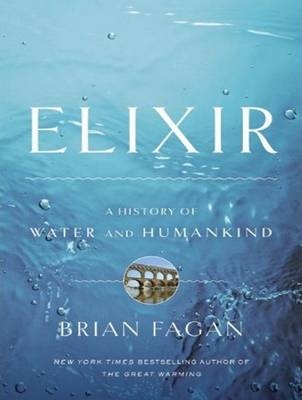
Elixir: A History of Water and Humankind
by Brian Fagan • Bloomsbury Press, 2011, 384 pp.
This spring’s flooding of the Assiniboine River in Saskatchewan and Manitoba and the Richelieu River in Quebec has thrust surrounding communities into crisis. The inundation of farmlands has destroyed crops and livelihoods. Homes have been lost. Meanwhile drought along the Yangtze River has made drinking water increasingly inaccessible for millions of Chinese citizens. Although the urgent needs generated by these water-based crises are different, they point to the same conclusion. Despite our pretensions to the contrary, our relationship to water remains precarious and will become more so as the climate changes in unpredictable ways.
Humanity’s relationship with water is the subject of Brian Fagan’s Elixir: A History of Water and Humankind. In keeping with his best books, Fagan cleverly mixes his erudition with beautifully written depictions of life in the distant past. The combination leaves the reader feeling he is on a journey of discovery. We learn how gravity dictates the flow of water and how early human communities devised water diversion schemes that made irrigation possible. We learn of the enormous human toll of past civilizations’ great water monuments and how steam power made water accessible to depths hitherto unimaginable, thereby fundamentally altering our relationship to the ‘elixir’ of life. With the advent of steam power, water was increasingly treated as simply a commodity to be bought and sold and as a resource vital to our mastery over the planet. It is these narrowly defined approaches to water to which Fagan takes serious exception. Indeed the book’s twin themes are that fresh water must be conceived of as a finite resource and our ongoing attempts to achieve mastery over water are doomed to failure. If we are to survive our looming water crises, there must instead be a respect – indeed reverence – for humanity’s most precious resource.
Fagan is most insightful when he establishes the deeper connections between water and the rise and fall of distant civilizations. Throughout history the harnessing of water’s power has been designed to bring more land under cultivation and increase crop yields. As yields increased, so too did populations and population densities, thereby requiring further increases in a landscape’s productivity. But in arid and semi-arid landscapes in particular, ongoing attempts to increase crop yields often imposed unsustainable stresses on both the land and the dependent communities. To take one example, the Sassanian Empire (224 C.E.-652 C.E.) encompassed territory that included Iran, Iraq, much of The Persian Gulf and the Arabian Peninsula, Armenia and the Southern Caucasus. Prisoners of war were used to build irrigation works between the Tigris and Euphrates Rivers. Consequently ever bigger tracts of land were brought under cultivation. As the scale of projects increased, control over them often passed from the village level to more centralized authorities. Responses to any water management crises were thus less nimble and ultimately less effective. Increasing the number of irrigation works eventually produced less drainage. Soils were thus damaged at a time when population densities were increasing. As yields decreased, moreover, farmers no longer had the option of reverting to a more nomadic lifestyle. The results were disastrous. As Fagan makes clear, declining land productivity precipitated sharp reductions in food production and accompanying increases in epidemic disease. Even today much of the land brought under cultivation between the Tigris and the Euphrates Rivers is salt laden and unproductive.
Fagan’s deep awareness of water’s vital role in any civilization’s fate is what makes the book’s final chapter devoted to our current predicament such compelling reading. Although he talks of having a ‘reverence’ for water, it is rooted not in religion, but rather our looming water related challenges. This is in keeping with the elementary truth preached by environmentalists: we must respect nature’s limits if our civilization is to survive and thrive. There is little evidence, however, that water’s limits are understood or respected. On the contrary, water is still treated as an infinitely renewable resource that should be manipulated at almost any cost to meet human ends. Los Angeles is the archetypical example of a city built using water diverted from rivers and lakes hundreds of miles away. The construction of aqueducts made water diversion and thus irrigation possible in what remains a semi-arid landscape. As Fagan makes clear, however, such increases cannot continue indefinitely. Water tables are falling in, among other places, China, India and the United States – precisely the countries where demand for the resource is accelerating exponentially. The Ganges as well as many of the world’s other great rivers have diminished flows, even as the number of people they serve continues to rise. The Tigris, Euphrates and Nile Rivers are among the river basins in which much of humanity live and which are shared by many countries. Indeed the combination of reduced river flows and growing demand for water points to ominous possibilities. To take one example, Turkey’s plans to produce hydro electric dams using both the Tigris and the Euphrates Rivers may seriously diminish water flow and access in both Syria and Iraq. How will Turkey’s neighbours respond? As this scenario suggests, many of the world’s future conflicts may very well be over water.






